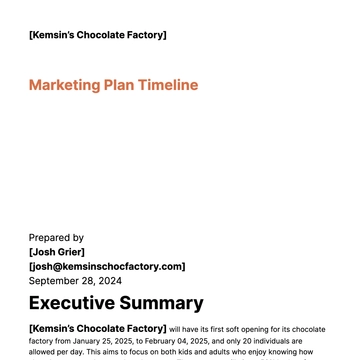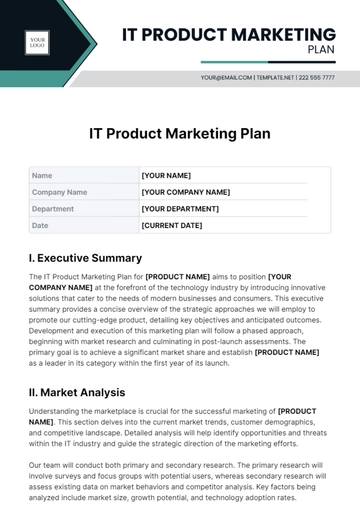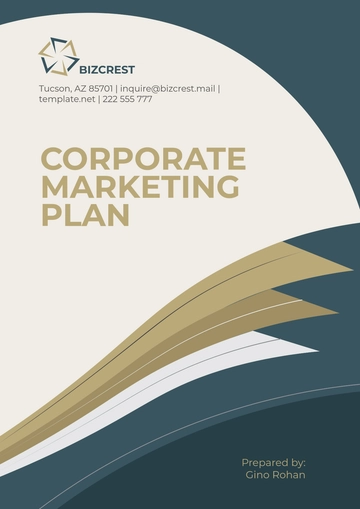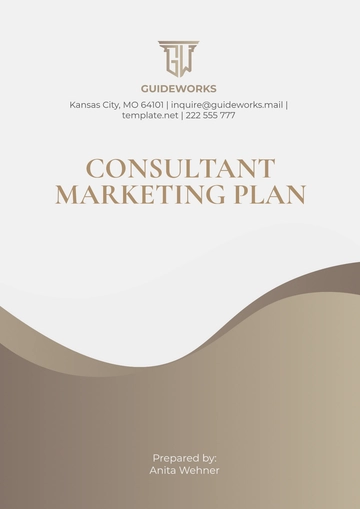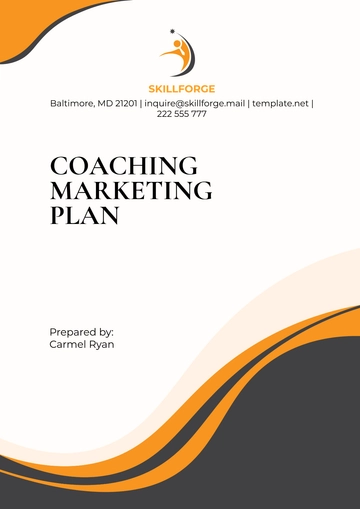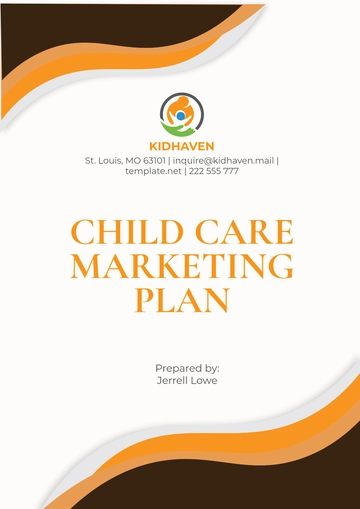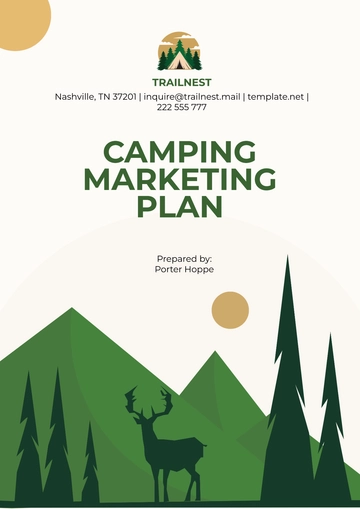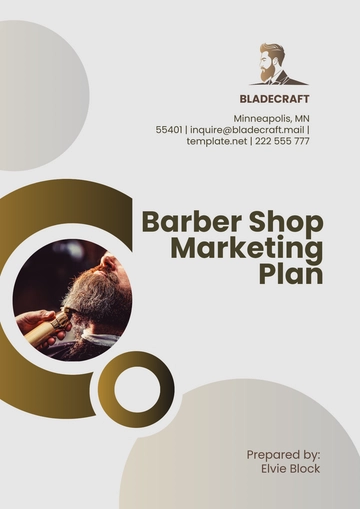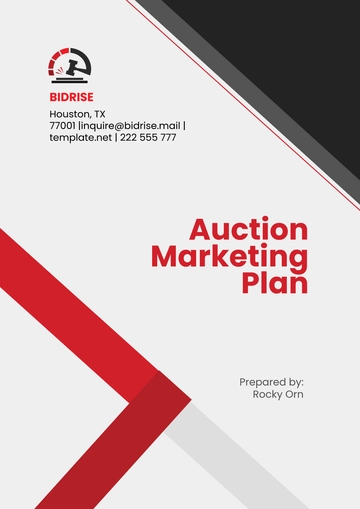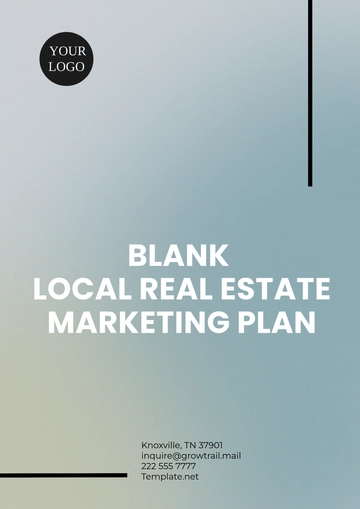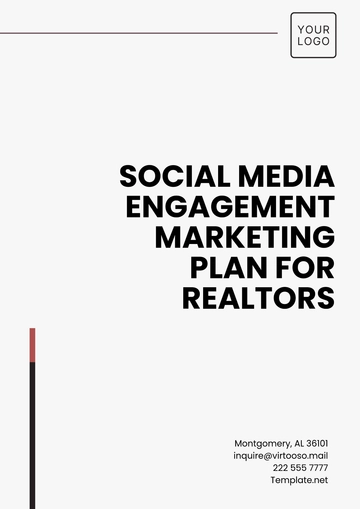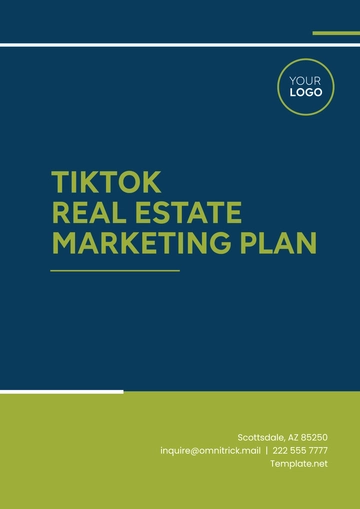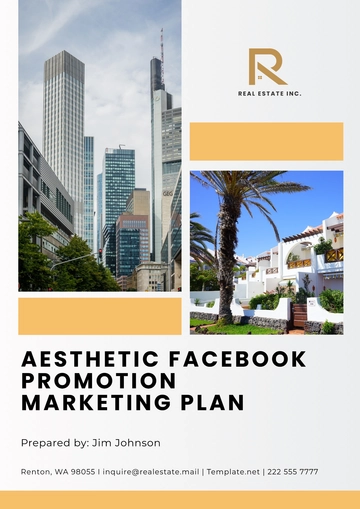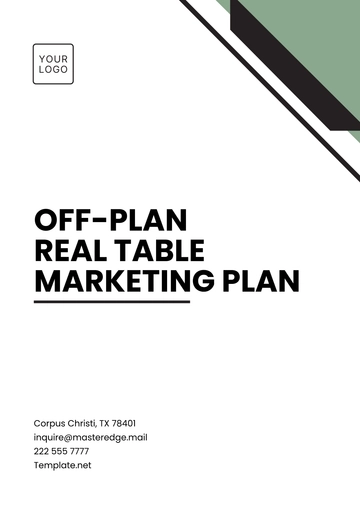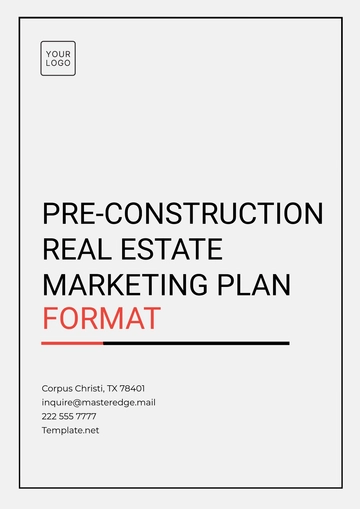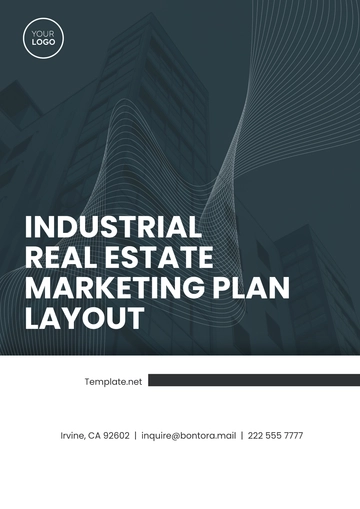Free Sample Restaurant Marketing Plan
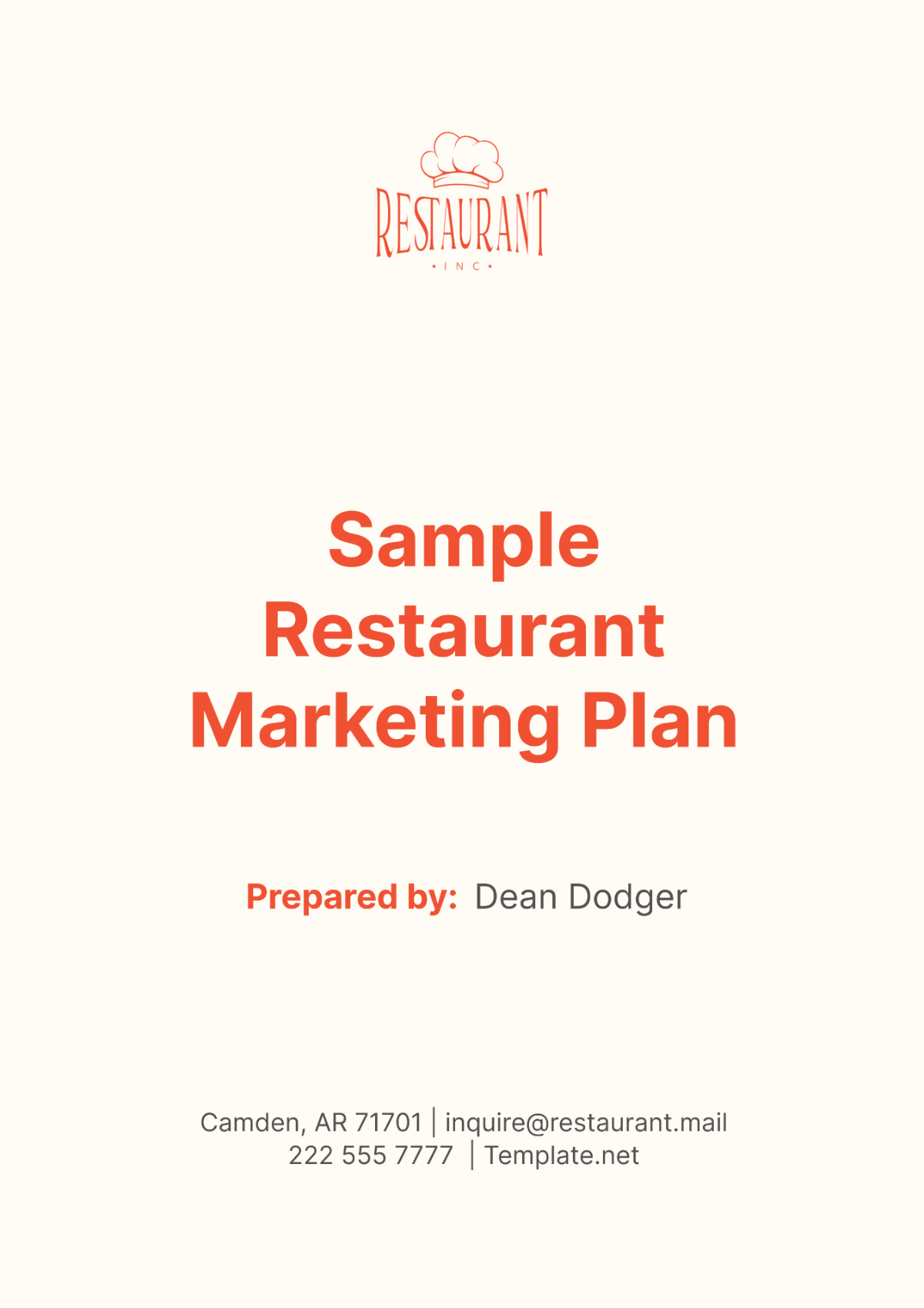
I. Executive Summary
This marketing plan embodies our blueprint for elevating [Your Company Name], integrating our profound knowledge of our target demographic, specific marketing objectives, and marketing strategies tailored to align with the preferences of our audience.
Our approach is deeply informed by an extensive analysis of our target audience, including their eating habits and way of life, which has been key to developing a story that not only promotes our restaurant but also builds rapport with our clientele. We aim to engage our audience, create excitement about our establishment, and, ultimately, improve its reputation and expand our customer community through our marketing activities.
The allocated budget is $16,000 and has been carefully designed to effectively distribute funds across different components, taking into account the potential impact and return on investment for each activity to maximize outcomes.
II. Marketing Objectives
These objectives are designed to ensure that our marketing strategies align with our overall business goals and provide a roadmap for success:
A. Short-Term Objectives
Our short-term objectives focus on the immediate goals that we aim to achieve within the first year of implementing our marketing plan. These objectives are crucial for gaining momentum and establishing our presence in the market:
Monthly Revenue: Our primary financial objective is to achieve a monthly revenue of $50,000 within the first six months. This will be measured by tracking our monthly sales and comparing them with our revenue target.
Customer Base: We aim to build a strong customer base of 1,000 customers in the first year. This will be measured by tracking the number of unique customers who dine at our restaurant.
Customer Retention: Another key objective is to achieve a customer retention rate of 60% within the first year. This will be measured by tracking the number of repeat customers.
B. Long-Term Objectives
Our long-term objectives focus on the goals that we aim to achieve in the next 2 to 5 years. These objectives are crucial for ensuring the sustained growth and success of our restaurant:
Brand Presence: We aim to establish a strong brand presence in the local market within 2 years. This will be measured by conducting brand awareness surveys and tracking the number of mentions and reviews of our restaurant in local media.
Expansion: We plan to expand to additional locations within 3-5 years. This will be measured by the number of new restaurant locations we open.
Market Share: Another key long-term objective is to achieve a market share of 25% within 5 years. This will be measured by comparing our sales with the total sales of restaurants in our market.
III. Target Audience
Our marketing strategies are designed to resonate with our target audience and meet their dining needs and preferences. We have identified two key segments within our target audience:
A. Primary Target Audience
Demographics: Our primary target audience is in the age group of 25-40 years. They are young professionals who are well-established in their careers and have a disposable income that allows them to enjoy upscale dining experiences.
Geographics: These individuals are located within the city limits, making our restaurant easily accessible to them. They are urban dwellers who appreciate the convenience of city life.
Psychographics: Our primary target audience values quality and uniqueness in their dining experiences. They are adventurous and open to trying new cuisines. They also value good service and a pleasant dining ambiance.
Behavioral Traits: These individuals often dine out and are likely to become regular customers if they like the food and the overall dining experience at our restaurant. They are also active on social media and often share their dining experiences online, which can provide us with additional publicity.
B. Secondary Target Audience
Demographics: Our secondary target audience includes families with children and individuals of all ages who enjoy good food. They may not dine out as frequently as our primary target audience, but when they do, they prefer quality dining options.
Geographics: These individuals are located within the city and its suburbs. They are willing to travel a bit for a good dining experience.
Psychographics: Our secondary target audience values family-friendly dining options. They appreciate a diverse menu that caters to different tastes and dietary preferences. They also value good service and a comfortable dining ambiance.
Behavioral Traits: These individuals are likely to become repeat customers if they enjoy their dining experience at our restaurant. They may also recommend our restaurant to their friends and family, providing us with word-of-mouth publicity.
IV. SWOT Analysis
SWOT analysis can help us leverage strengths, address weaknesses, capitalize on opportunities, and mitigate threats. The following table provides a detailed SWOT analysis of [Your Company Name]:
Strengths | Weaknesses |
|---|---|
Exceptional Cuisine | New Market Entry |
Prime Location | High Operational Costs |
Opportunities | Threats |
Growing Local Economy | Strong Competition |
Increasing Demand for Dining Out | Market Saturation |
A. Strengths
Our strengths lie in our exceptional cuisine and prime location. Our restaurant offers a unique culinary experience that sets us apart from our competitors. Our menu also is carefully curated to cater to a variety of tastes and preferences, ensuring a memorable dining experience for our customers. Moreover, our prime location, situated in a bustling area, makes us easily accessible and visible to potential customers.
B. Weaknesses
As a new entrant in the market, we face certain challenges. Building a strong customer base and brand recognition takes time and effort. Additionally, the high operational costs, including rent, salaries, and food costs, can impact our profitability. However, we are committed to addressing these challenges and turning them into opportunities for growth.
C. Opportunities
We operate in a growing local economy with an increasing demand for dining out. This presents us with ample opportunities to attract more customers and expand our business. We plan to leverage these opportunities by offering promotional deals, hosting events, and continuously improving our menu and services based on customer feedback.
D. Threats
The restaurant industry is highly competitive, with many established players in the market. This competition, coupled with market saturation, poses a threat to our business. However, we believe that our unique offerings and customer-centric approach will enable us to carve out a niche for ourselves in the market.
Overall, this analysis provides us with valuable insights into our business and the market in which we operate. It helps us understand our competitive position and guides our marketing strategies. By leveraging our strengths and opportunities, and addressing our weaknesses and threats, we can ensure the success of our marketing efforts and the growth of our restaurant.
V. Marketing Strategies
At [Your Company Name], we believe in developing comprehensive marketing strategies that cater to all aspects of our business. Our strategies are designed to highlight the unique offerings of our restaurant, engage with our target audience, and achieve our marketing objectives.
A. Product
Our product strategy focuses on our exceptional cuisine that sets us apart from our competitors. We aim to continuously innovate and offer a unique culinary experience to our customers.
Menu Innovation: Regularly update our menu to include new and unique dishes. This not only keeps our offerings fresh but also gives our customers a reason to keep coming back.
Quality Ingredients: Use high-quality ingredients in our dishes. This not only enhances the taste but also communicates our commitment to quality to our customers.
Presentation: Pay attention to the presentation of our dishes. A visually appealing dish can enhance the dining experience and make our restaurant more memorable.
Unique Culinary Experience: Create a unique culinary experience that goes beyond just food. This could include themed nights, chef’s specials, or interactive dining experiences.
B. Price
Our pricing strategy is designed to reflect the quality of our offerings while remaining accessible to our target audience.
Competitive Pricing: Set our prices competitively to attract our target audience. While our prices reflect the quality of our food and service, they should also be accessible to our target audience.
Value for Money: Ensure that our customers receive value for their money. This includes serving generous portions, offering complimentary items, and ensuring a high level of service.
Special Offers: Run special offers during off-peak hours or on slow days. This can attract more customers and increase sales during these times.
Loyalty Program: Implement a loyalty program that offers discounts or rewards to regular customers. This can encourage repeat visits and build customer loyalty.
C. Place
Our place strategy focuses on leveraging our prime location to attract foot traffic and make our restaurant a destination for the local community.
Visibility: Ensure that our restaurant is easily visible from the main road. This can attract passing foot traffic and increase awareness of our restaurant.
Accessibility: Ensure that our restaurant is easily accessible by both public and private transport. This can make it convenient for our customers to visit us.
Ambiance: Pay attention to the ambiance of our restaurant. A pleasant and comfortable ambiance can enhance the dining experience and make our customers want to stay longer.
Hygiene and Cleanliness: Maintain high standards of hygiene and cleanliness in our restaurant. This is crucial for ensuring the health and safety of our customers and staff.
D. Promotion
Our promotion strategy involves developing a promotional campaign that leverages both traditional media and digital platforms.
Advertising: Run ads in local newspapers, magazines, and online platforms. This can increase awareness of our restaurant and attract more customers.
Social Media: Use social media platforms to engage with our audience, share updates, and run promotions. This can increase our online presence and reach a larger audience.
Events: Host events at our restaurant, such as tasting nights, themed dinners, or live music nights. This can create buzz around our restaurant and attract more customers.
Partnerships: Form partnerships with local businesses or events for cross-promotion. This can increase our reach and attract new customers.
VI. Marketing Channels
Each channel offers unique advantages and can help us achieve specific marketing objectives. By using a mix of channels, we can ensure that our marketing messages reach our audience through multiple touchpoints.
A. Digital Marketing
Digital marketing allows us to reach a large audience at a relatively low cost. It also provides us with the ability to target our audience based on their interests, behaviors, and demographics. Here are some strategies we plan to implement:
Social Media Platforms: We will use social media platforms such as Facebook, Instagram, and Twitter to engage with our audience, share updates, and run promotions. Regularly posting engaging content can increase our online presence and reach a larger audience.
Website: We will develop a well-designed website that provides information about our restaurant, menu, location, and contact details. The website will also include customer testimonials, a reservation system, and a blog with engaging content.
Email Marketing: We will build an email list and send regular newsletters with updates, promotions, and engaging content. Email marketing can help us maintain a direct line of communication with our customers.
B. Events
Hosting events at our restaurant can create a buzz and attract more customers. Events provide customers with a unique dining experience and give them a reason to visit our restaurant. Here are some events we plan to organize:
Tasting Nights: We will host tasting nights where customers can sample a variety of dishes from our menu. This can attract food enthusiasts and give them a chance to explore our culinary offerings.
Themed Dinners: We will organize themed dinners based on different cuisines, seasons, or occasions. Themed dinners can provide a unique dining experience and attract a diverse crowd.
Collaborations: We will collaborate with local artists and musicians for special events. These collaborations can provide unique experiences and attract new customers.
C. Partnerships
Forming strategic partnerships can provide us with additional marketing channels and increase our reach. Here are some partnerships we plan to form:
Local Businesses: We will partner with local businesses for cross-promotion. This can increase our visibility among their customers and attract new customers to our restaurant.
Tourist Attractions: We will collaborate with local tourist attractions to offer special deals or packages. This can attract tourists to our restaurant and increase our customer base.
VII. Budget
A well-planned budget is crucial for the success of any marketing campaign. It ensures that resources are allocated effectively across various activities, allowing us to maximize the impact of our efforts. The following chart and table provide the detailed breakdown of the estimated costs for each activity:
Marketing Activity | Budget |
|---|---|
Social Media Advertising | $5,000 |
Website Development and Maintenance | $3,500 |
Email Marketing | $1,500 |
Events and Promotions | $4,000 |
Print Advertising | $2,000 |
Total | $16,000 |
A. Social Media Advertising
Social media advertising, with an allocation of $5,000, forms a significant part of our budget. This includes running targeted ads on platforms like Facebook, Instagram, and Twitter. These platforms allow us to reach a large audience and target users based on their interests, behaviors, and demographics. By investing in social media advertising, we can increase our online presence, engage with our audience, and drive traffic to our restaurant.
B. Website Development and Maintenance
Website development and maintenance, with a budget of $3,500, is crucial for our online presence. A well-designed and user-friendly website can attract more visitors, provide them with necessary information, and encourage them to visit our restaurant. Regular maintenance ensures that our website is always up-to-date and provides a seamless user experience.
C. Email Marketing
Email marketing, with a budget of $1,500, is an effective way to maintain direct communication with our customers. By sending regular newsletters with updates, promotions, and engaging content, we can keep our customers informed and encourage them to visit our restaurant.
D. Events and Promotions
Events and promotions, with a budget of $4,000, are crucial for creating a buzz around our restaurant and attracting more customers. This includes hosting tasting nights, themed dinners, and collaborations with local artists and musicians. These events provide a unique dining experience and give customers a reason to visit our restaurant.
E. Print Advertising
Print advertising, with a budget of $2,000, is a traditional yet effective way to reach certain segments of our audience. Despite the digital age, print media like local newspapers and magazines still have a wide reach and can help us connect with potential customers who prefer traditional media channels.
F. Total
The total budget for our marketing campaign is $16,000. This budget has been carefully planned to ensure that each activity receives adequate funding, thereby maximizing the effectiveness of our campaign. By allocating our resources wisely, we can ensure that our marketing efforts yield the best possible results.
The budget breakdown not only offers a transparent view but also guarantees that each activity receives sufficient financing. It's crucial to acknowledge that every element, from social media advertising to events and promotions, is essential in promoting the restaurant and drawing in customers. Thus, a carefully crafted budget is not merely about prudent spending but also about making sure that every dollar expended aids in fulfilling our marketing goals.
VIII. Monitoring and Evaluation
Monitoring and evaluation allow us to track the effectiveness of our marketing strategies, make necessary adjustments, and ensure that we are on track to achieve our marketing objectives.
A. Key Performance Indicators (KPIs)
Key Performance Indicators (KPIs) are measurable values that demonstrate how effectively we are achieving our marketing objectives. We will implement KPIs to monitor the effectiveness of our marketing strategies. Here are some KPIs we plan to use:
Customer Acquisition Cost: This KPI will help us understand how much it costs to acquire a new customer through our marketing efforts. It is calculated by dividing the total marketing spend by the number of new customers acquired during a specific period.
Customer Retention Rate: This KPI will help us measure the percentage of customers who return to our restaurant. A high customer retention rate indicates that customers are satisfied with our restaurant and are likely to return.
Social Media Engagement: This KPI will help us measure the level of engagement on our social media platforms. It includes metrics such as likes, shares, comments, and follower growth.
Website Traffic: This KPI will help us measure the number of people visiting our website. It includes metrics such as the number of unique visitors, page views, and the average time spent on the website.
Conversion Rate: This KPI will help us measure the percentage of website visitors who take a desired action, such as making a reservation or signing up for a newsletter.
B. Regular Review and Adjustment
We will regularly review our marketing plan and make necessary adjustments based on our KPI outcomes. This will ensure that our marketing strategies remain effective and aligned with our marketing objectives. Here are some strategies we plan to implement:
Performance Analysis: We will regularly analyze the performance of our marketing strategies to understand what is working and what is not. This includes looking at our KPIs, customer feedback, and market trends.
Adjustments: Based on our performance analysis, we will make necessary adjustments to our marketing strategies. This could include tweaking our social media strategy, adjusting our ad spend, or revising our pricing strategy.
A/B Testing: We will conduct A/B testing to determine the most effective strategies. This involves comparing two versions of an ad or post to see which performs better.
Feedback: We will actively seek feedback from our customers and incorporate it into our marketing strategies. This can help us meet the needs and preferences of our customers more effectively.
IX. Conclusion
This marketing plan outlines a strategic approach to promote [Your Company Name]. The plan is rooted in a deep understanding of our target audience and their dining preferences, which has shaped a compelling narrative that not only markets the restaurant but also creates a connection with the audience.
Our marketing strategies, including the use of diverse online marketing platforms, organizing events, and establishing strategic alliances, aim to generate excitement about our restaurant and draw in a greater number of patrons. These strategies align with our short-term and long-term objectives. We are confident that with this marketing plan, [Your Company Name] is poised to make a significant impact in the restaurant industry and achieve sustained growth and success.
- 100% Customizable, free editor
- Access 1 Million+ Templates, photo’s & graphics
- Download or share as a template
- Click and replace photos, graphics, text, backgrounds
- Resize, crop, AI write & more
- Access advanced editor
Plan your marketing activities effectively with the Sample Restaurant Marketing Plan Template available on Template.net! This editable template offers a comprehensive framework for marketing initiatives. Customize it to meet your restaurant’s unique needs with the customizable features. Use the AI Editor Tool to create a detailed and actionable marketing plan!

